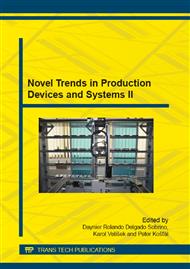p.74
p.80
p.86
p.92
p.98
p.104
p.110
p.117
p.123
Automation of Force Assessment Generated by Upper Limb for Ergonomic System EAWS
Abstract:
Ergonomic assessment systems were created for possibility of prediction and risk detection at workplace. Ergonomic assessment system EAWS (European Assembly Work-Sheet) includes assessment of body postures, action forces, weight of carrying loads and frequently recurring upper limb loads assessment. Assessment of action forces (forces generated by upper limb defined by EAWS) is problematic and there is a lack of means for effective assessment. This paper deals with design of electronic device for assessment of action forces generated by upper limb defined by EAWS with using of thin film FSR (force sensing resistor). The paper deals with identification of upper limb areas, where the generated forces are important for assessment by EAWS, deployment of sensors in identified areas, calibration of FSR sensor with regard to simply program implementation in microcontroller, determination of action forces in every by EAWS defined action force application and construction of sensing and evaluating part of electronic device.
Info:
Periodical:
Pages:
98-103
Citation:
Online since:
December 2014
Authors:
Keywords:
Price:
Сopyright:
© 2014 Trans Tech Publications Ltd. All Rights Reserved
Share:
Citation:


